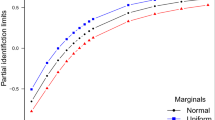Abstract
Two algorithms for establishing a connection between correlations before and after ordinalization under a wide spectrum of nonnormal underlying bivariate distributions are developed by extending the iteratively found normal-based results via the power polynomials. These algorithms are designed to compute the polychoric correlation when the ordinal correlation is specified, and vice versa, along with the distributional properties of latent, continuous variables that are subsequently ordinalized through thresholds dictated by the marginal proportions. The method has broad applicability in the simulation and random number generation world where modeling the relationships between these correlation types is of interest.





Similar content being viewed by others
References
Amatya A, Demirtas H (2015) Simultaneous generation of multivariate mixed data with Poisson and normal marginals. J Stat Comput Simul 85:3129–3139
Barbiero A, Ferrari PA (2015) Simulation of ordinal and discrete variables with given correlation matrix and marginal distributions, R package GenOrd. https://cran.r-project.org/web/packages/GenOrd
Cario MC, Nelson BR (1997) Modeling and generating random vectors with arbitrary marginal distributions and correlation matrix (Technical Report). Department of Industrial Engineering and Management Services Northwestern University, Evanston, IL, USA
Demirtas H (2004) Simulation-driven inferences for multiply imputed longitudinal datasets. Stat Neerl 58:466–482
Demirtas H (2005) Multiple imputation under Bayesianly smoothed pattern-mixture models for non-ignorable drop-out. Stat Med 24:2345–2363
Demirtas H (2006) A method for multivariate ordinal data generation given marginal distributions and correlations. J Stat Comput Simul 76:1017–1025
Demirtas H (2007) Practical advice on how to impute continuous data when the ultimate interest centers on dichotomized outcomes through pre-specified thresholds. Commun Stat Simul Comput 36:871–889
Demirtas H (2016a) A note on the relationship between the phi coefficient and the tetrachoric correlation under nonnormal underlying distributions. Am Stat. doi:10.1080/00031305.2015.1077161
Demirtas H (2016b) Concurrent generation of binary and nonnormal continuous data through fifth order power polynomials. Commun Stat Simul Comput. doi:10.1080/03610918.2014.963613
Demirtas H, Arguelles LM, Chung H, Hedeker D (2007) On the performance of bias-reduction techniques for variance estimation in approximate Bayesian bootstrap imputation. Comput Stat Data Anal 51:4064–4068
Demirtas H, Doganay B (2012) Simultaneous generation of binary and normal data with specified marginal and association structures. J Biopharm Stat 22:223–236
Demirtas H, Freels SA, Yucel RM (2008) Plausibility of multivariate normality assumption when multiply imputing non-Gaussian continuous outcomes: a simulation assessment. J Stat Comput Simul 78:69–84
Demirtas H, Hedeker D (2007) Gaussianization-based quasi-imputation and expansion strategies for incomplete correlated binary responses. Stat Med 26:782–799
Demirtas H, Hedeker D (2008a) Multiple imputation under power polynomials. Commun Stat Simul Comput 37:1682–1695
Demirtas H, Hedeker D (2008b) An imputation strategy for incomplete longitudinal ordinal data. Stat Med 27:4086–4093
Demirtas H, Hedeker D (2011) A practical way for computing approximate lower and upper correlation bounds. Am Stat 65:104–109
Demirtas H, Hedeker D (2016) Computing the point-biserial correlation under any underlying continuous distribution. Commun Stat Simul Comput. doi:10.1080/03610918.2014.920883
Demirtas H, Hedeker D, Mermelstein JM (2012) Simulation of massive public health data by power polynomials. Stat Med 31:3337–3346
Demirtas H, Schafer JL (2003) On the performance of random-coefficient pattern-mixture models for non-ignorable drop-out. Stat Med 22:2553–2575
Demirtas H, Yavuz Y (2015) Concurrent generation of ordinal and normal data. J Biopharm Stat 25:635–650
Emrich JL, Piedmonte MR (1991) A method for generating high-dimensional multivariate binary variates. Am Stat 45:302–304
Ferrari PA, Barbiero A (2012) Simulating ordinal data. Multivar Behav Res 47:566–589
Fleishman AI (1978) A method for simulating non-normal distributions. Psychometrika 43:521–532
Fréchet M (1951) Sur les tableaux de corrélation dont les marges sont données. Annales de l’Université de Lyon Section A 14:53–77
Headrick TC (2002) Fast fifth-order polynomial transforms for generating univariate and multivariate nonnormal distributions. Comput Stat Data Anal 40:685–711
Headrick TC (2010) Statistical simulation: power method polynomials and other transformations. Chapman and Hall/CRC, Boca Raton
Hoeffding W (1940) Scale-invariant correlation theory. In: Fisher NI, Sen PK (eds) The collected works of Wassily Hoeffding. Springer, New York, pp 57–107 (1994)
Inan G, Demirtas H (2015) Data generation with binary and continuous non-normal components, R package BinNonNor. https://cran.r-project.org/web/packages/BinNonNor
Shi Y, Demirtas H (2015) Simultaneous generation of count and continuous data, R package PoisNonNor. https://cran.r-project.org/web/packages/PoisNonNor
Vale CD, Maurelli VA (1983) Simulating multivariate nonnormal distributions. Psychometrika 48:465–471
Wang Y, Demirtas H (2015), Concurrent generation of binary, ordinal and continuous data, R package BinOrdNonNor. https://cran.r-project.org/web/packages/BinOrdNonNor
Author information
Authors and Affiliations
Corresponding author
Rights and permissions
About this article
Cite this article
Demirtas, H., Ahmadian, R., Atis, S. et al. A nonnormal look at polychoric correlations: modeling the change in correlations before and after discretization. Comput Stat 31, 1385–1401 (2016). https://doi.org/10.1007/s00180-016-0653-7
Received:
Accepted:
Published:
Issue Date:
DOI: https://doi.org/10.1007/s00180-016-0653-7




